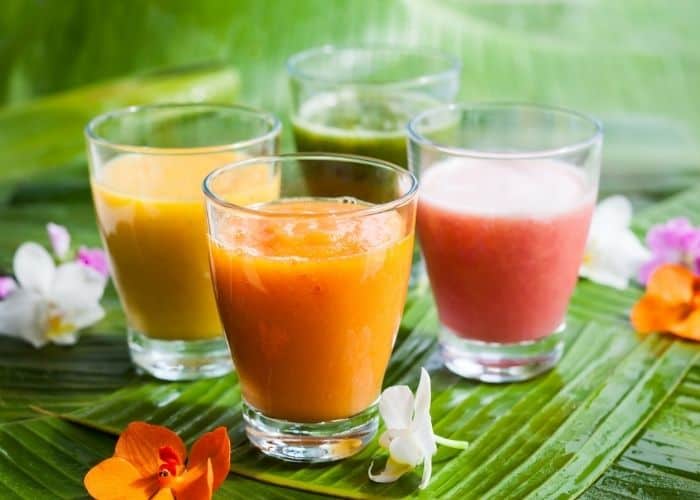
So, you’ve taken the plunge and decided to start juicing?
Awesome!
I’m sure the next question on your mind is how much juice you should be drinking per day so that your diet is nutritionally balanced.
When juicing, how much should I drink a day? You should drink approximately 16 to 32 oz (0.5 to 1 L) of fresh juice daily to supplement your diet. If you’re doing a juice cleanse, then you should drink at least 6 servings, or 96 oz (3 L).
Not sure where you fit into that?
No worries. I’ll break down the different types of juices and how much you should drink of those so you can feel comfortable with incorporating juicing into your diet.
In this article, I’ll go over:
- What juicing is
- Benefits of juicing for weight loss
- How long it takes to see results from juicing
- A drinking guide for the different types of juice (veg, fruit, green, cold-press, and even for a juice cleanse)
Let’s get started!
Table of Contents
What is Juicing?
Juicing is the process of extracting the juice from raw produce.
Essentially, juicing turns all the flesh into a drinkable liquid and separates that from the pulp. What you do with the pulp afterward is entirely up to you.
It’s an easy way to get your fruit and veggie servings in per day without actually having to crunch down on anything.
Because juices are highly concentrated, you need to watch your consumption. Juices don’t contain fiber and they may have too much sugar, especially if you’re diabetic.

Types of Juicers
There are two main types of juicers:
- Masticating
- Centrifugal
In case you don’t already have a juicer, here are the differences between the two.
A masticating juicer crushes the produce using an augur, slowly releasing juice without oxidizing the nutrients.
They’re generally considered to be higher quality and although they take a longer time to yield juice, the yield is often GREATER than a centrifugal juicer’s.
I personally use a masticating juicer all the time.
A centrifugal juicer uses centrifugal force to create juice by spinning a blade (or blades) at high speeds to separate the juice from the pulp.
Unfortunately, they use heat and that can damage the nutrients in the juice, which is the whole reason behind juicing. They tend to cost less and if you need to make a lot of juice, the centrifugal juicer will get the job done more quickly.
You won’t go wrong with either juicer.
What’s important is that you take the step to juice to cleanse your body of toxins and introduce micronutrients your body may not have seen in A LONG TIME.
Why Should You Juice?
Of course, you don’t have to juice if you really don’t want to.
But, juicing is a great way to pack nutrients into your body at a pace you’d hardly be able to match just by eating.
For example, would you eat a whole cucumber by yourself? Probably not, but you’ll drink it in about 10 minutes with little effort.
Weight-Friendly Tip
If you’re doing a juice cleanse for the first time, it’s likely because your doctor gave you bad news or your body’s telling you it feels terrible and needs a change. Or, maybe you just want to lead a healthier life. Either way, it will take about 3 days for your body to adapt to a juice-only diet, so don’t give up on Day 1.Let’s face it…
With all the fast food and processed food costing so little, it’s easy for your body to be deprived of essential nutrients. The best place to get them is from fruits and vegetables.
Benefits of Juicing for Weight Loss
Now that you know why you should juice and what juicing actually is, I’m sure you’re eager to hear all about how juicing can help you lose weight.
I know I sure was.
There are many health benefits to juicing, but one of the main benefits of juicing is that it fills you up and keeps you satiated, preventing you from eating empty calories and making bad choices.
Here are seven benefits of juicing:
- Higher energy, focus, and concentration
- Gut health and improved digestion
- Liver detoxification (and the rest of the digestive system)
- Increased sensory perception (smell, taste, etc.)
- Decreased appetite (your body is getting what it needs!)
- Increased keratin, making your hair, skin, and nails pretty
- Stronger immune system
Your body’s functions are so interrelated that making a change in one area can have a profound effect on other.
ALL of those benefits above can assist you on your weight loss journey.
How Long Does it Take to See Results From Juicing?
Great question!
If you’re doing a juice cleanse or detox, then it’s going to take your body 3 days (72 hours) to get adjusted to a juice-only diet. If you’re juicing daily to supplement your diet, you should notice small improvements to your overall health in 1 week (7 days).
But, what’s really important is to not give up on juicing immediately. It’s okay if you’re not in love with the taste or flavor in the beginning.
Weight-Friendly Tip
According to research published in Current Gastroenterology Reports, juicing diets tend to work because they lead to extremely low caloric intake for short periods of time, however, they tend to lead to weight gain once a normal diet is resumed. That’s why I recommend incorporating a serving or two of juice into your daily diet to keep your body satiated.You can alter your juicing recipe(s) down the road and have fun experimenting.
Juicing is a drug your body won’t mind you getting high on, provided you juice the right kinds of foods.
When Juicing, How Much Should I Drink a Day?
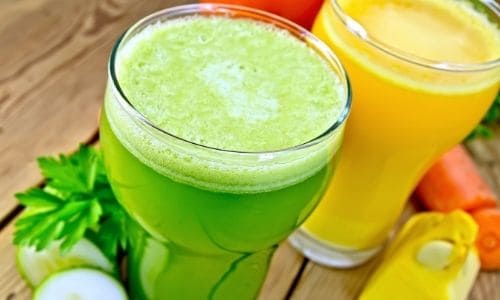
This is what you came to this article for.
When you went to Google and typed in “When juicing, how much should I drink a day?” this is the answer you’re looking for.
You should drink approximately 16 to 32 oz (0.5 to 1 L) of fresh juice daily to supplement your diet. If you’re doing a juice cleanse, then you should drink at least 6 servings, or 96 oz (3 L).
But, there are different types of juice and we will go over later how they influence how much juice you should drink a day.
When Juicing, How Much is a Serving?
This goes hand-in-hand with how much juice you should be drinking a day.
Of course you need to know the serving size.
One serving of fresh juice is 16 ounces (2 cups), or approximately 1 liter. To supplement your diet, you should drink 1-2 servings of juice a day. If you’re going on a juice detox and only drinking juice, you should drink 6-8 servings a day.
The only exception to this is fruit juice, but we will get to that shortly.
Drinking Guide for Different Types of Juicing
As promised, here is the guide for how much juice you should drink depending on the type of juice and the purpose of juicing.
To recap, here are the different kinds of juice:
- Juice for a detox/cleanse
- Juicing in general
- Green juice
- Veg juice
- Fruit juice
- Cold-pressed juice
I’ll go over all them in more detail, but here’s a bird’s eye overview of the different types of juicing and the recommended quantities for each.
Drinking Guide for Different Types of Juice
| Type of Juice | How Much Juice Per Day? | Number of Servings |
|---|---|---|
| Juice Fast | 96 oz (3 L) | 6 servings |
| Green Juice | 16 to 32 oz (0.5 to 1 L) | 1 to 2 servings |
| Vegetable Juice | 16 to 32 oz (0.5 to 1 L) | 1 to 2 servings |
| Fruit Juice | 8 oz (0.25 L) | 1/2 of a serving |
| Cold-Pressed Juice | 16 oz (0.5 L) | 1 serving |
| Juice (in General) | 16 to 32 oz (0.5 to 1 L) | 1 to 2 servings |
One important detail about juicing you should know about is that juices work best when consumed fresh. They’ll start to go bad about 2-3 days after being made, so drink them quickly.
Juice isn’t the kind of thing you can batch at the beginning of the week and store for several days.
The quality won’t be as good.
How Much Juice Should You Drink a Day on a Juice Fast?
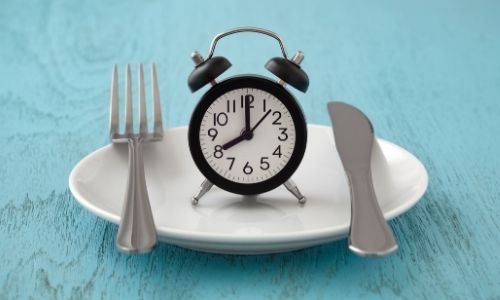
If you’re on a:
- Juice fast
- Juice detox
- Juice cleanse
Then you’re going to be consuming A LOT of fresh juice daily.
If you’re on a juice fast, you should aim to drink 6 to 8 servings of fresh juice a day. That equates to about 96 to 128 ounces of juice (about 3 to 4 liters) per day. Ideally, you should be drinking juice about every 2 to 2 1/2 hours.
You’ll have to go pee a lot and that’s quite common.
The juice is flushing out the toxins in your body.
When juice is replacing all food, you really do need to consume a lot. But, please, watch your sugar intake and consult a doctor if things get out of hand.
How Much Green Juice Should You Drink in a Day?
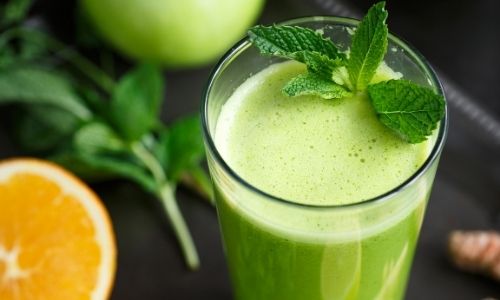
Green juice is juice that ends up green.
Sounds simple enough, right?
Green juice contains vegetables and can contain fruit, like apples. You should consume 1 to 2 servings of juice per day, or 16 to 32 oz (0.5 to 1 L).
Focus on juicing veggies and fruits with less sugar. But, it’s totally normal to start out with a sweeter juice and then wean off some of the sugary produce once you get used to the taste.
Some green vegetables have clear-colored flesh (cucumber, for example), so make sure you juice the skin, too. That’s the best way to amp up juice flavor, color, and nutrients.
How Much Veg Juice Per Day?
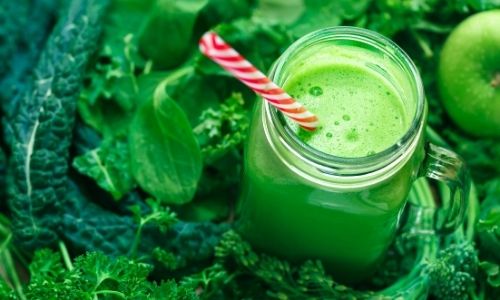
Unlike green juice which can contain fruits, veg juice is just vegetables.
You should consume 1 to 2 servings of veg juice per day, or 16 to 32 oz (0.5 to 1 L). It will likely be less sweet than green juice, but there’s nothing more refreshing and nutritious than pure vegetables.
There are plenty of green vegetables you can juice, such as:
- Spinach
- Kale
- Cucumber
- Parsley
- Celery
And, so much more!
Keep trying out different recipes and combinations until you find the juice you like the most.
How Much Fruit Juice Should You Drink a Day?
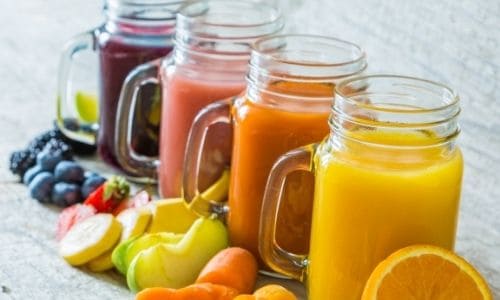
Fruit juice is the kind of juice that’s great in small quantities, but should not be drunk in great ones.
Because fruit juice contains a lot of natural sugars, you should only drink 8 oz (0.25 L) of fruit juice per day if you’re an adult and 4 to 5 oz if you’re a kid. It’s best to consume it early in the morning so your body can process the sugar.
Fruit juice should be as colorful as the rainbow!
That’s how you know it’s fresh.
Weight-Friendly Tip
If you’re not sure what kind of fruit juice to try first, consider orange juice. You probably already drink it, but it will be tastier fresh. We reviewed the 18 best oranges for juicing here.According to Heather Caswell, a nutrition scientist working for the British Nutrition Foundation, the relatively high energy content of fruit juice (derived from sugars naturally present in the fruit) may be one reason why fruit juice consumption has been linked with concerns over weight gain.
Remember, excess sugar consumption leads to it being converted into fat.
Diabetics should stay as far away from fruit juice as possible, or their blood sugar levels will skyrocket.
How Much Cold-Pressed Juice Should I Drink a Day?
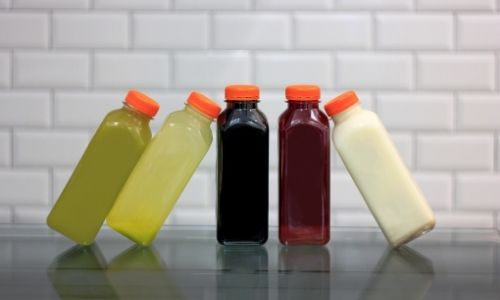
The best way to drink cold-pressed juice is by the bottle.
Cold-pressed juices typically come in a 16-ounce (1 L) bottle, which is one serving.
Cold-pressed juice is made using the pressure from a hydraulic press to release as much juice as possible from the pulp without damaging the nutrient quality.
It’s a pretty cool science.
Cold-pressed juices aren’t cheap, though, which is why I prefer making my own juice with a masticating juicer.
Conclusion
In this article, I answered the question “When juicing, how much juice should I drink a day?”
In case you scrolled past it, here was my answer.
You should drink approximately 16 to 32 oz (0.5 to 1 L) of fresh juice daily to supplement your diet. If you’re doing a juice cleanse, then you should drink at least 6 servings, or 96 oz (3 L).
I also went over:
- What juicing is
- Benefits of juicing for weight loss
- How long it takes to see results from juicing
- A drinking guide for the different types of juice (veg, fruit, green, cold-press, and even for a juice cleanse)
I hope you feel confident incorporating juice into your diet or even being gutsy with a full-on juice cleanse. I’m here to support you no matter how much or how little you juice.
Drop any juicing questions in the comments below and I look forward to answering them. I’d love to hear about your weight loss journey.
To your weight-loss success!

